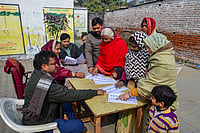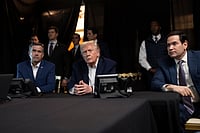As we see the AAP, a party that emerged on the back of a massive post-corruption plank battling against the arrest of its leader in a corruption case, the ideological arc seems to have come a full circle.
How can Shiv Sena (UBT), once the flag-bearer of aggressive Hindutva and son-of-the-soil politics, find itself on the same page as the secular-liberal Congress?
Even though historians in the early 1990s had predicted the end of ideology and ideology-based politics with the fall of the Soviet Union, it continues to influence political narratives and trajectories in the world’s largest democracy.
In its latest issue, Outlook looks at the ideological origins and journeys of various regional parties, ranging from the Adivasi-backed JMM to the Dravidian DMK. The once separatist and now moderate Kashmiri parties, the Janata parivar parties that later became each other’s arch-nemeses (RJD-JDU-SP), the champion of Ma-Mati-Manush – TMC – and the regional stalwarts of Andhra-Telangana (BRS and YSR-CP) also find a place among these comprehensive accounts of the satraps that have held sway in their respective regions and their relationships with power and people.






















